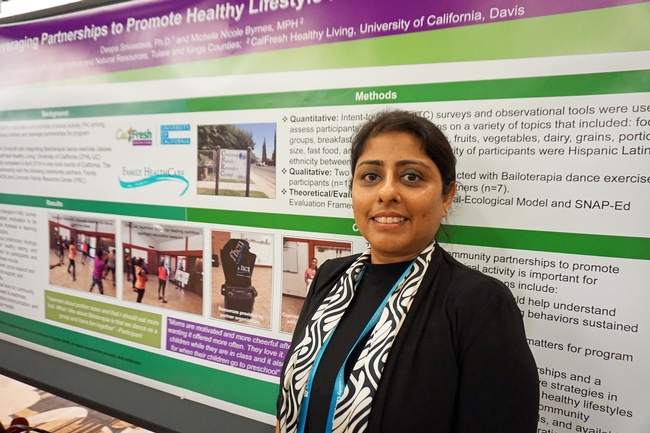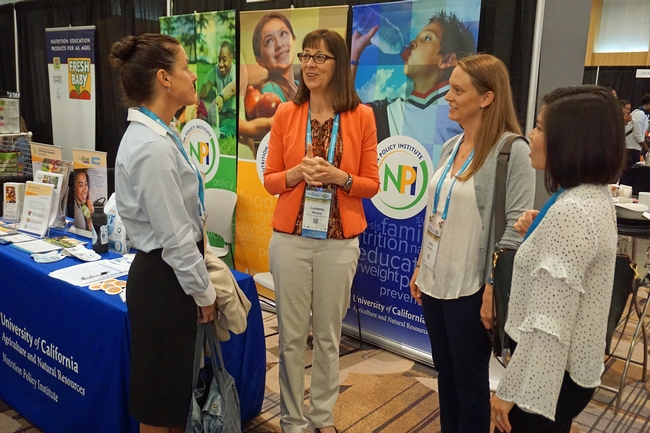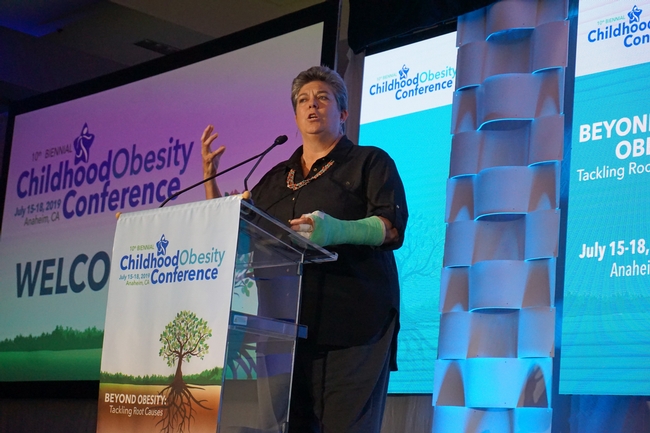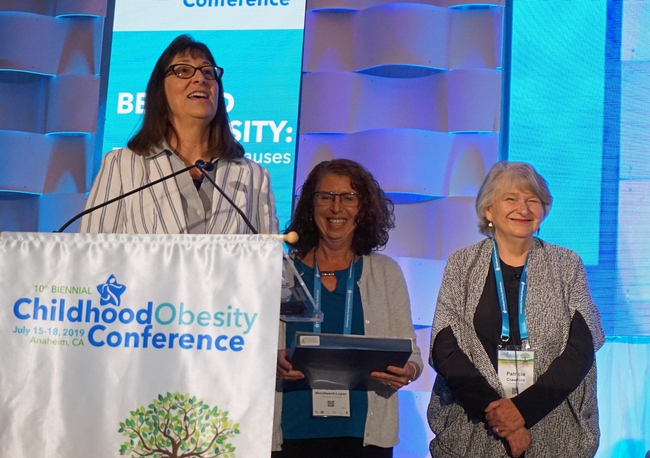Posts Tagged: obesity
UC researcher is promoting healthy families in Tulare and Kings county communities
In a new series starting today, UC ANR features a sampling of our academics whose work exemplifies the public value UC ANR brings to California.
UC Cooperative Extension nutrition, family and consumer sciences advisor Deepa Srivastava arrived in the San Joaquin Valley in 2017 to conduct a research and education program that makes children and families healthier in Tulare and Kings counties.
Srivastava joined Cooperative Extension with diverse experience in obesity prevention research and program implementation and evaluation. Her job combines extension, research, university and public service to promote healthy living among families and children in low-income communities.
“I could hardly believe how well this job fit my interests, skills and education,” she said. “I have been involved in research and implementation and evaluation of nutrition education programs in the Department of Nutrition at the University of Nebraska-Lincoln. The UCCE position is ideal.”
Born in India, Srivastava immigrated to the United States after completing undergraduate and graduate degrees in her home state of Allahabad. She also earned a master's degree at North Dakota State University before moving to Nebraska, where she earned a Ph.D. in human sciences, with specialization in child, youth and family studies. After completing her doctorate degree at the University of Nebraska-Lincoln, Srivastava also worked as a project lead for the Ecological Approach to (EAT) Family Style project.
“My educational background and diverse experience prepared me to be a professional in the field of childhood obesity prevention and nutrition education,” Srivastava said.
Srivastava manages two federally funded nutrition programs for low income residents of Tulare and Kings counties. The CalFresh Healthy Living program presents information on food safety, food resource management, gardening, physical activity and youth engagement. Educators reach out to elementary schools to help develop school wellness policies and make lunchroom changes that steer children toward making nutritious food choices.
The second program, the Expanded Food and Nutrition Education Program, presents a series of classes to low-income families at community centers, schools and other service centers. The classes help participants stretch their food dollars, select and prepare healthy foods and take part in physical activity.
To shape her research program in Tulare and Kings counties, Srivastava conducted a needs assessment study to understand nutrition practices in early childhood education settings. Tulare and Kings counties are among the counties in the state with high levels of obesity and food insecurity.
Following her needs assessment, Srivastava concluded a successful pilot focused on preschoolers in Kings County. She and her nutrition team in Kings County, in partnership with the Department of Hospitality Management at West Hills Community College-Lemoore and preschools located at the college campus, implemented a collaborative nutrition education program to help preschoolers learn about healthy eating.
Srivastava is conducting further research to assess program sustainability and community engagement efforts, including how nutrition education offered by UCCE in Tulare and Kings counties motivates children and families to improve their knowledge, attitude, skills and behavior. Her research aims to understand the influences on children's eating and physical activity practices.
Srivastava is actively involved in obesity prevention initiatives within UC ANR and at the local, statewide and national level. Working with local community partners, she and her team have already introduced a number of change initiatives in Tulare and Kings counties to promote healthy lifestyles across lifespan, such as establishing new school gardens, youth engagement projects, healthy youth farmer's market and physical activity such as walking clubs and dance exercise classes.
“Our team is supported by experts from the University of California who are on the cutting-edge of the latest research and curriculum design,” Srivastava said.
Srivastava and her team were recognized at the National Extension Association for Family & Consumer Sciences conference in Hershey, Penn., in October 2019, where they won two SNAP-Ed/EFNEP awards: third-place at the national level and first place for the Western region.
“I am proud of my team's passion and hard work,” she said. “Our nutrition education programs have meaningful private and public values that promote healthy people and communities.”
Food insecurity and childhood obesity: Is there a connection?
A well-nourished population requires that all members of society have access to sufficient amounts of nutritious food. Unfortunately, food insecurity continues to be a staggering problem throughout the world with negative consequences in terms of health and well-being.
In the United States, millions of households, an estimated 1 in 8 Americans, lack access to enough food. Children growing up in food insecure households face many challenges, such as behavioral problems, lower academic achievement, disrupted social interactions and poor health. The prevailing belief is that children living in a food insecure environment are at greater risk of undernutrition, not obesity. Although this may be true in some cases, food insecurity and childhood obesity also coexist.
Because childhood food insecurity may increase obesity risk later in life, it is important to better understand the relationship between food insecurity and children's obesity, and how it varies by demographic characteristics in the United States.
A recent study published in the September 2019 issue of The Journal of Nutrition assessed the relationship between household food insecurity and child adiposity-related outcomes. This included variables such as body mass index, waist circumference and diet outcomes. The study, conducted by Lauren Au, a researcher at UC Agriculture and Natural Resources' Nutrition Policy Institute, and colleagues examined associations by age, sex, and race/ethnicity. Data collected in 2013-2015 from 5,138 U.S. schoolchildren ages 4-15 years old from 130 communities in the cross-sectional Healthy Communities Study were analyzed.
Household food insecurity was self-reported using a two-item screening instrument and dietary intake was assessed using a food frequency questionnaire. Information on dietary behaviors, physical activity and demographics was collected. To assess adiposity, children's weight, height and waist circumference were measured.
Study results support an association between food-insecure households and measures of adiposity. Children from food-insecure households had high body mass index, waist circumference, greater odds of being classified as overweight or obese, consumed more sugar from sugar-sweetened beverages, and less frequently ate breakfast and dinner with family compared to children from food-secure households. When examined by age groups, significant relationships were observed only for older children, however, results did not differ according to sex or race/ethnicity.
These results suggest that household food insecurity is associated with higher child adiposity-related outcomes and several nutrition behaviors, particularly among older children. Clearly, further research is needed to better understand the complexities of food insecurity, childhood obesity, and future health outcomes.
Read the full open access article.
This research was supported by the National Heart, Lung, and Blood Institute, part of the National Institutes of Health.
Children are getting healthier, but the obesity crisis is not over
Real progress has been made in tackling the epidemic of childhood obesity since the first California Childhood Obesity Conference was held 20 years ago, but there is more work to be done.
“Collectively, we have come so far,” UC Nutrition Policy Institute Director Lorrene Ritchie told an audience of 1,025 public health, nutrition education, research, and other professionals at the event in Anaheim in July 2019. NPI was one of six conference hosts.
In the last 20 years:
- Federal school meal standards have been revised so that the food children eat at school is healthier than the lunches they bring from home.
- Sugar-sweetened beverages are no longer available to students during the school day.
- Foods provided by the Special Supplemental Nutrition Program for Women, Infants and Children (WIC) are healthier and give mothers incentive to breast feed their babies.
- The Supplemental Nutrition Assistance Program (SNAP) education component is now linked to policy, systems and environmental changes.
- The Child and Adult Care Food Program now provides healthier meals and snacks to children in childcare centers and homes across the country.
The average quality of the diet of American children has improved, but the rate of childhood obesity in the United States is still too high.
According to the Centers for Disease Control and Prevention, 18.5% of U.S. children and adolescents 2 to 19 years old are obese – about 13.7 million youth in all. The rates trend higher in minority communities, with 25.8% of Latinx youth and 22% of African American youth obese. Obesity is also more prevalent among children in families with low incomes.
Obesity, which is defined in children as a body mass index at or above the 95th percentile of CDC growth charts, is associated with poorer mental health status, reduced quality of life, and increased prevalence of diabetes, heart disease, stroke and some types of cancer.
The vice president of UC Agriculture and Natural Resources, Glenda Humiston, pledged the organization's commitment to community health and wellbeing at the Childhood Obesity Conference. UC ANR is the umbrella organization of the Nutrition Policy Institute, UC CalFresh Healthy Living, UC Cooperative Extension, 4-H Youth Development, the UC Master Gardener Program and the California Naturalist Program, among others.
“Going forward, solutions to the obesity epidemic are multidisciplinary,” Humiston said. “NPI does world class work in conducting research to influence nutrition policy. We need to harness 4-H. Master Gardeners are increasingly focusing on edible gardens. CalNat is getting people out into nature. We are finding synergies in community wellness.”
Humiston has dedicated UC ANR resources to finding and implementing solutions to the obesity crisis.
“I'm looking forward to working with all of you – public and private organizations – to design a way to move forward,” she said.
The opening keynote presentation at the conference featured Patricia Crawford, NPI's Senior Director of Research emeritus, a pioneer in addressing the growing problem of childhood obesity during her long career. Beginning in the 1970s, she recognized that childhood obesity was on the rise and launched several studies to search for the causes and potential solutions.
In one study, Crawford followed a group of 9-year-old African American girls over a period of 10 years to determine why these youth were growing up heavier than other adolescents.
“Finally, we began to get some answers,” Crawford said. “We learned obesity wasn't the children's fault. They were living in environments that made the unhealthy choice cheaper and easier to find. It's so unfair for people who have fewer resources. Health disparities has to be the No. 1 thing we are working on to address chronic disease rates in this country.”
“The solution to obesity is prevention. It's cheaper and more effective than treatment,” Crawford continued. “Healthy food is a taste that is easy to acquire if it is not preempted by junk food.”
Crawford said she honed in on the best strategies for prevention by actively listening to people struggling to make healthy choices
“There is a chasm between research and community,” Crawford said. “We have to get people together from the research level and the policy level with folks on the ground. We need to learn from people.”
Joining forces to promote child health and wellness
According to current statistics, approximately 40 percent of school-age children in the U.S. are overweight or obese. This statistic is reflected in rising rates of diabetes, pre-diabetes, and heart disease risk factors. Nearly one-quarter of all children are pre-diabetic or diabetic at the time when they leave high school, a figure that has increased dramatically in the last decade. Dental problems, the other very common health problem of youth, carry the potential for current and future pain, infection, and tooth loss. Although low-income children and children of color are at particular risk for both conditions, risk is unacceptably high for all children.
It is important to note that these all-too-common conditions share the same critical risk factor: consumption of sugary foods and beverages. Unknown to many, over half of the added sugar consumed by children is ingested in liquid form—soda, fruit drinks, sports drinks, energy drinks, and other pre-sweetened beverages including iced teas and others. For teenagers sugar-sweetened beverages are the single largest source of calories in their daily diet. Further, research has demonstrated that liquid sugar is more highly related to obesity than added sugar coming in solid form.
To improve the medical and dental health of our children we need to help children and families find ways to reduce their consumption of sugar-sweetened beverages.
Fortunately research is being conducted to find effective ways to reduce children's sweetened beverage consumption.
- Reduce provision of sweetened beverages in the school, after school and childcare settings. UC ANR's Nutrition Policy Institute (NPI) has documented dramatic reductions in sugary beverage consumption after the enactment of state restrictions on the sale of highly sugared beverages in California schools and childcare. While much has been accomplished, more can be done to see that these kinds of restrictions are fully maintained.
- Offering children easy access to water stations and other free tap water sources in childcare settings, schools and recreational facilities provides a healthful alternative to sugary beverages.
- Encourage strong nutrition education programs for children. UC Cooperative Extension's EFNEP and statewide SNAP-Ed programs have been leading efforts to educate children on the value of a healthy diet including the risk of consuming too many sugary beverages.
- Similarly, educating families on healthy eating and on the benefits of reducing sugar-sweetened beverage consumption can support and reinforce the messages to children in the school-based programs.
A consistent message on sugary beverages delivered to families by dental and medical health practitioners, in tandem with other educational and community efforts, can substantially benefit children's health. As respected community members, dental and medical health practitioners are in a position to deliver consistent messages to families and also to work with community agencies and groups, including UC ANR and its affiliates, to initiate and support efforts to reduce children's and families' sugary beverage consumption. Our children deserve a healthy start.
For more information, see:
- Nutrition Policy Institute (http://npi.ucanr.edu)
- National Drinking Water Alliance (http://www.drinkingwateralliance.org/about)
- Dooley D, Moultrie N, Sites E, Crawford P. Primary care interventions to reduce childhood obesity and sugar-sweetened beverage consumption: Food for thought for oral health professionals. Journal of Public Health Dentistry, 16 June 2017. DOI:10.1111/jphd.12229.
UC's Pat Crawford weighs in on childhood obesity
Today marks the start of the 9th Biennial Childhood Obesity Conference. Since it's founding 18 years ago by UC ANR Specialist Pat Crawford, it has grown from a small gathering of California researchers, educators, and health care professionals to the nation's largest gathering on the topic of pediatric obesity/overweight.
So today seems the perfect time to revisit a 2015 conversation with Rose Hayden-Smith, UC's Food Observer, and Crawford, now the Senior Director of Research at UC ANR's Nutrition Policy Institute. As Pat stated in her interview—
“Not changing is risky. The United States – along with Mexico – has the highest obesity rates in the industrialized world. With these extraordinarily high obesity rates, we are on a path toward ever-rising chronic disease rates including not just diabetes, but also heart disease and some cancers, increasing health care costs and reducing productivity.
Even more alarming, is a little known fact that 23 percent of the adolescents in this country currently have pre-diabetes or diabetes as measured by actual blood tests in our largest national study of health (NHANES). Something is seriously wrong in a society such as ours where so many children are growing up with such a high risk of preventable disease.”
You can read the complete interview at the UC Food Observer. You'll also find a recent story about the 45 youth advocates from organizations around California joining this year's conference to bring the voices of youth to this vital conversation.








